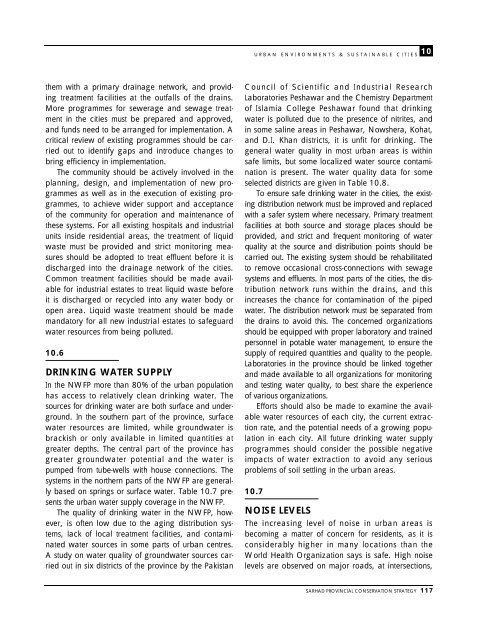Sarhad Provincial Conservation Strategy - IUCN
Sarhad Provincial Conservation Strategy - IUCN
Sarhad Provincial Conservation Strategy - IUCN
Create successful ePaper yourself
Turn your PDF publications into a flip-book with our unique Google optimized e-Paper software.
them with a primary drainage network, and providing<br />
treatment facilities at the outfalls of the drains.<br />
More programmes for sewerage and sewage treatment<br />
in the cities must be prepared and approved,<br />
and funds need to be arranged for implementation. A<br />
critical review of existing programmes should be carried<br />
out to identify gaps and introduce changes to<br />
bring efficiency in implementation.<br />
The community should be actively involved in the<br />
planning, design, and implementation of new programmes<br />
as well as in the execution of existing programmes,<br />
to achieve wider support and acceptance<br />
of the community for operation and maintenance of<br />
these systems. For all existing hospitals and industrial<br />
units inside residential areas, the treatment of liquid<br />
waste must be provided and strict monitoring measures<br />
should be adopted to treat effluent before it is<br />
discharged into the drainage network of the cities.<br />
Common treatment facilities should be made available<br />
for industrial estates to treat liquid waste before<br />
it is discharged or recycled into any water body or<br />
open area. Liquid waste treatment should be made<br />
mandatory for all new industrial estates to safeguard<br />
water resources from being polluted.<br />
1 0 . 6<br />
DRINKING WATER SUPPLY<br />
In the NWFP more than 80% of the urban population<br />
has access to relatively clean drinking water. The<br />
sources for drinking water are both surface and underground.<br />
In the southern part of the province, surface<br />
water resources are limited, while groundwater is<br />
brackish or only available in limited quantities at<br />
greater depths. The central part of the province has<br />
greater groundwater potential and the water is<br />
pumped from tube-wells with house connections. The<br />
systems in the northern parts of the NWFP are generally<br />
based on springs or surface water. Table 10.7 presents<br />
the urban water supply coverage in the NWFP.<br />
The quality of drinking water in the NWFP, however,<br />
is often low due to the aging distribution systems,<br />
lack of local treatment facilities, and contaminated<br />
water sources in some parts of urban centres.<br />
A study on water quality of groundwater sources carried<br />
out in six districts of the province by the Pakistan<br />
U R B A N E N V I R O N M E N T S & S U S T A I N A B L E C I T I E S 10<br />
Council of Scientific and Industrial Research<br />
Laboratories Peshawar and the Chemistry Department<br />
of Islamia College Peshawar found that drinking<br />
water is polluted due to the presence of nitrites, and<br />
in some saline areas in Peshawar, Nowshera, Kohat,<br />
and D.I. Khan districts, it is unfit for drinking. The<br />
general water quality in most urban areas is within<br />
safe limits, but some localized water source contamination<br />
is present. The water quality data for some<br />
selected districts are given in Table 10.8.<br />
To ensure safe drinking water in the cities, the existing<br />
distribution network must be improved and replaced<br />
with a safer system where necessary. Primary treatment<br />
facilities at both source and storage places should be<br />
provided, and strict and frequent monitoring of water<br />
quality at the source and distribution points should be<br />
carried out. The existing system should be rehabilitated<br />
to remove occasional cross-connections with sewage<br />
systems and effluents. In most parts of the cities, the distribution<br />
network runs within the drains, and this<br />
increases the chance for contamination of the piped<br />
water. The distribution network must be separated from<br />
the drains to avoid this. The concerned organizations<br />
should be equipped with proper laboratory and trained<br />
personnel in potable water management, to ensure the<br />
supply of required quantities and quality to the people.<br />
Laboratories in the province should be linked together<br />
and made available to all organizations for monitoring<br />
and testing water quality, to best share the experience<br />
of various organizations.<br />
Efforts should also be made to examine the available<br />
water resources of each city, the current extraction<br />
rate, and the potential needs of a growing population<br />
in each city. All future drinking water supply<br />
programmes should consider the possible negative<br />
impacts of water extraction to avoid any serious<br />
problems of soil settling in the urban areas.<br />
1 0 . 7<br />
NOISE LEVELS<br />
The increasing level of noise in urban areas is<br />
becoming a matter of concern for residents, as it is<br />
considerably higher in many locations than the<br />
World Health Organization says is safe. High noise<br />
levels are observed on major roads, at intersections,<br />
SARHAD PROVINCIAL CONSERVATION STRATEGY 117

















